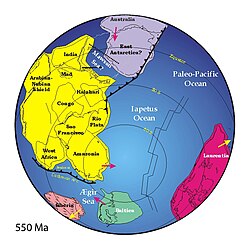Pannotia
Pannotia (also called Greater Gondwanaland or the Vendian supercontinent) is a Neoproterozoic supercontinent. It may have existed during the Ediacaran period (~600 mya), to the end of the Precambrian (about 541 mya). After that, it split into smaller continents. The small ones were Laurentia, Siberia and Baltica, with the main landmass Gondwana south of them.[1]


Lifespan
changeAbout 750 million years ago the older supercontinent Rodinia split apart into three continents. These were earlier forms of Laurasia and Gondwana, and the continental craton of Congo. About 600 milion years ago, they formed Pannotia.
Pannotia did not last for long. The collisions that formed Pannotia were brief collisions, and the continents making up Pannotia already had active rifting. By about 550 million years ago, Pannotia separated into four continents. This means it only lasted for about 50 million years. Later the four landmasses would combine again to form the next supercontinent, Pangaea.[2]
Related pages
changeReferences
change- ↑ "Pannotia". Palaeos. Archived from the original on 2006-03-13. Retrieved 2013-05-12.
- ↑ "Pannotia". UCMP Glossary. Archived from the original on 2012-02-04. Retrieved 2013-05-12.
Other websites
change- An image showing Pannotia according to Christopher Scotese. (it is referred to as the late Precambrian Supercontinent in the image).
- Torsvik, Trond Helge. "Palaeozoic Continent Margins: Late Cambrian (500 Ma)". Archived from the original on 23 July 2011. Retrieved 18 June 2010.
- Stampfli, Gérard. "Prototethys (Ordovician): Early Ordovician (490 Ma) reconstruction". Archived from the original on 18 January 2012. Retrieved 23 September 2010.